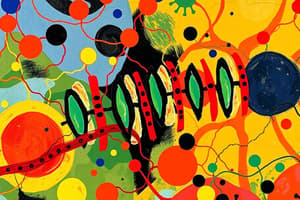Podcast
Questions and Answers
Quel est le nom du processus qui se produit lorsque les télomères atteignent une longueur critique?
Quel est le nom du processus qui se produit lorsque les télomères atteignent une longueur critique?
- Stabilité génétique
- Sénescence réplicative (correct)
- Apoptose programmée
- Mortalité cellulaire
Quel est le rôle des télomères dans la sénescence cellulaire?
Quel est le rôle des télomères dans la sénescence cellulaire?
- Ils stimulent la prolifération cellulaire
- Ils protègent les chromosomes contre les dommages oxydatifs
- Ils régulent la différenciation cellulaire
- Ils déclenchent une réponse de dommages à l'ADN, conduisant à la sénescence cellulaire (correct)
Quels sont les marqueurs de la sénescence cellulaire?
Quels sont les marqueurs de la sénescence cellulaire?
- Télomères courts et SASP (correct)
- Oncogènes et stresse oxydatif
- Télomères longs et apoptose
- Marqueurs de surface cellulaire et mort cellulaire
Quel est le résultat de la perte de fonction des télomères?
Quel est le résultat de la perte de fonction des télomères?
Quel est le nom des chercheurs qui ont établi le lien entre l'attrition des télomères et la sénescence?
Quel est le nom des chercheurs qui ont établi le lien entre l'attrition des télomères et la sénescence?
Quel est le but des stratégies thérapeutiques basées sur les télomères?
Quel est le but des stratégies thérapeutiques basées sur les télomères?
Quel est le marqueur de la sénescence cellulaire qui est caractérisé par la sécrétion de cytokines pro-inflammatoires et de facteurs de croissance?
Quel est le marqueur de la sénescence cellulaire qui est caractérisé par la sécrétion de cytokines pro-inflammatoires et de facteurs de croissance?
Quel est le marqueur de la sénescence cellulaire qui permet de détecter les cellules sénescentes en temps réel?
Quel est le marqueur de la sénescence cellulaire qui permet de détecter les cellules sénescentes en temps réel?
Quel est le rôle des télomères dans la sénescence cellulaire?
Quel est le rôle des télomères dans la sénescence cellulaire?
Quel est le résultat de la sécrétion de cytokines pro-inflammatoires et de facteurs de croissance par les cellules sénescentes?
Quel est le résultat de la sécrétion de cytokines pro-inflammatoires et de facteurs de croissance par les cellules sénescentes?
Quel est le mécanisme qui caractérisé la sénescence cellulaire?
Quel est le mécanisme qui caractérisé la sénescence cellulaire?
Quel est le rôle des protéines inhibitrices du cycle cellulaire dans la sénescence cellulaire?
Quel est le rôle des protéines inhibitrices du cycle cellulaire dans la sénescence cellulaire?
Flashcards are hidden until you start studying
Study Notes
Cellular Senescence: Understanding Markers and Telomere Roles
Cellular senescence is a crucial aspect of aging, characterized by irreversible cell cycle arrest in response to various stressors and damage. This article will delve into the markers and mechanisms of cellular senescence, with a particular focus on telomeres, which play a significant role in senescence.
Markers of Cellular Senescence
Cellular senescence can be identified through specific markers, such as the senescence-associated secretory phenotype (SASP), an increase in senescence-associated β-galactosidase (SA-β-gal) activity, and the presence of cell cycle-inhibitory proteins, notably cyclin-dependent kinase inhibitors like p16.
Senescence-Associated Secretory Phenotype (SASP)
SASP is a distinct feature of senescent cells, characterized by the secretion of various pro-inflammatory cytokines, chemokines, and growth factors. This secretory phenotype can affect the surrounding tissue and contribute to impaired tissue regeneration and chronic age-associated diseases.
Cell Surface Markers
Recent advances in technology have led to the development of innovative imaging-based tools and fluorescent tracers to monitor senescence burden in real time. These markers can help distinguish senescent cells from their healthy counterparts and enable the prospective isolation of senescent cells from aged and diseased tissues.
Role of Telomeres in Cellular Senescence
Telomeres are the protective caps at the ends of chromosomes, which shorten with each cell division. When telomeres reach a critical length, they trigger a DNA damage response, leading to cellular senescence. This process is known as replicative senescence.
Telomere Attrition and Senescence
The link between telomere attrition and senescence was first established by Leonard Hayflick and Paul Moorhead in 1961, who observed that normal cultured human fibroblasts display a finite capacity for cell division. This finding led to the hypothesis that tissue aging is caused by cells progressively losing their ability to proliferate.
Telomere Dysfunction and Senescence
Telomere dysfunction can also induce senescence under stress conditions, such as oncogene activation or persistent DNA damage. In addition, telomere dysfunction can be a controlled program occurring in diverse biological processes, including embryonic development.
Telomere-Based Therapeutic Strategies
Understanding the role of telomeres in senescence has opened up new avenues for therapeutic intervention. Strategies aimed at modulating telomere length or stability have the potential to delay or alleviate cellular senescence and its associated effects on tissue function and overall health.
In conclusion, cellular senescence is a complex and dynamic process driven by various stressors and damage. The identification of specific markers, such as SASP and cell surface markers, has allowed researchers to better understand and target senescent cells. The role of telomeres in senescence, particularly through telomere attrition and dysfunction, has shed light on potential therapeutic strategies. As the field of senescence research continues to advance, these insights will be crucial in developing novel interventions to combat age-related diseases and promote healthy aging.
Studying That Suits You
Use AI to generate personalized quizzes and flashcards to suit your learning preferences.


